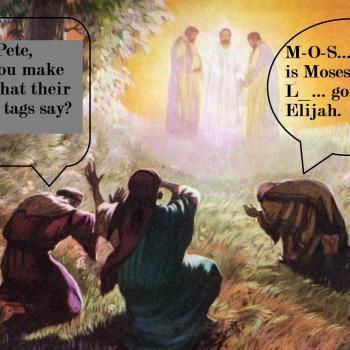You know the experience. You are reading something that should be familiar, and yet something new and unexpected jumps out at you.

That’s what happened to me not long ago, while reading the Greek New Testament in church on my phone.
One word literally jumped out at me. Well, it literally jumped out at me in the sense that a pop-up window jumps out at you.
The word ἐναγκαλισάμενος occurs twice in the New Testament, both times in Mark 9-10. And so I presume that I can be forgiven for having to click on the word in the Logos app to have it display the definition.
The root word ἀγκάλη has as its primary meaning bending, especially (indeed, almost exclusively) of the arms. The same root occurs in Luke 2:28, when Simeon takes the baby Jesus in his arms.
The definition/explanation the Logos app gave of the word in Mark 9:36 was that it means to embrace or to hug.
I had never previously read the text as indicating Jesus was hugging the child.
Many translations render the phrase by saying that Jesus took a child or children in his arms. Which is what hugging is. But hugging conjures up a different picture in the mind, and other translations simply hadn’t provoked the same mental image as this one did.
How have those of you who have studied the Gospel of Mark, and/or more specifically this passage, found this term to be translated? Did you always picture Jesus hugging the child, or did you imagine something else? I think in my own case, I initially imagined Jesus being passed a relatively small baby to hold. It isn’t the most natural way of conjuring up a visual image of what the text describes, I now realize. But “hold in his arms” fits that scenario better, while “hug” fits it being an older child better. Why do you think translators have rendered the passage as they have?
Of related interest:
https://readingacts.com/2018/12/06/become-like-a-child-matthew-181-4/
https://www.redletterchristians.org/in-pursuit-of-real-wisdom/













